Harristown
Houses within 15km of this house
Displaying 68 houses.
Houses within 15km of Harristown
Displaying 68 houses.
| House name | Description | |
|---|---|---|
| Clonalis House | The present Clonalis House was built in the late 1870s replacing an earlier Georgian house, the ruins of which can be seen at Clonalis. Charles Owen O'Conor, the O'Conor Don, lived here at the time of Griffith's Valuation when the existing house was valued at £35. In 1814 Clonalis is recorded as the residence of John Balfe. The Census of Elphin records Margaret O'Conor as residing in Clonalis in 1749. |

|
| Durrow | In 1786 Wilson refers to "Durra" as a seat of Mr. Bagot. At the time of Griffith's Valuation, Francis Hurley was leasing a property valued at £7 together with over 100 acres, from the Bagot estate at Durrow, barony of Ballymoe. A house is still extant at the site. |
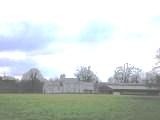
|
| The Hermitage | The original house, named Hamlet Cottage, was beside the road and is marked on the 1838 Ordnance Survey map. A new house was later built and is labelled The Hermitage on the 25-inch Ordnance Map of the 1890s. A house is still extant at the site. |
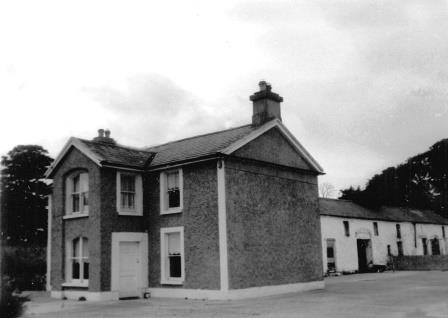
|
| Roseberry House | Described as 'an excellent two story slated house' in 1850. At the time of Griffith's Valuation it was held in fee by William Bodkin and valued at £15. This house is no longer extant. | |
| Springfield House | 18th century two-storey thatched house, described in 1863 as a house of ancient construction, still occuppied by the McDermott family in the early 20th century. At the time of Griffith's Valuation, it was occupied by Owen McDermott who was leasing from William McDermott and Glasgow Connolly and was valued at almost £12.. Portion of the house is still extant. |
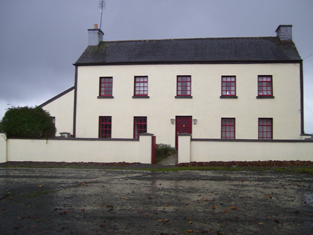
|
| Gorteen | The residence of Patrick O'Beirne by 1837 and of Anne O'Beirne at the time of Griffith's Valuation, who held the house from Patrick Grehan. It was valued at £8. The original house is no longer extant. | |
| Clooncah | A house built after the publication of the 1st Ordnance Survey map, at the time of Griffith's Valuation it was by John Love. The house was valued at £12 and held from John Armstrong. In 1885 Walford describes John Armstrong as a magistrate for county Galway, and of "Clooncagh and South Hill, Clifden". The site at Clooncah is now occupied by farm buildings. | |
| Turlough House (Ballymoe) | Held in fee by John Cheevers at the time of Griffith's Valuation when the buildings were valued at £7 10s. Occupied by John J. Cheevers in the early 20th century. This house is no longer extant | |
| Glinsk House | In 1786 Wilson refers to Glinsk as the "seat of the late Sir John Burke" and also as the seat of Sir Rickby Burke. Glinsk Castle and a substanial house are both marked on the 1838 Ordnance Survey map. The castle is shown on the 25-inch map of the 1890s but there is no trace of the house. At the time of Griffith's Valuation, Allen Pollok held buildings valued at £1 15 at the site, recorded as a herd's house. | |
| Newtown | John Burke, a gentleman, was living at Newtown in 1749. Valued at £4 in the mid 1850s. The property seems to have disappeared by the time of the 25-inch Ordnance map of the 1890s. | |
| French Park | At the time of Griffith's Valuation Frenchpark was owned by Rev. John Ffrench, Lord de Freyne and was valued at £60. In the 1749 Census of Elphin it was the residence of Arthur and Lady French. In 1786 Wilson described it as "a most beautiful seat with extensive and noble demesnes". It was demolished in the twentieth century. Members of the French family were buried in the graveyard surrounding the ruins of Frenchpark Priory. |

|
| Loughglynn | Loughglynn was the main residence of the Dillon family, built circa 1715, extended in the 1820s and altered again in the early 20th century. It is recorded in 1814, 1837 and in Griffith's Valuation as the seat of Viscount Dillon. The Dillons were absentee landlords for much of the nineteenth century and their agents, the Stricklands, lived in the house. During the twentiethcentury the house served as a convent. Loughglinn House is still extant. |

|
| Caher | Charles French was leasing the house at Caher, barony of Frenchpark, valued at £16, from Lord de Freyne's estate, at the time of Griffith's Valuation. Lewis also records the house as the residence of C. French in 1837. In the same year the Ordnance Survey Name books record Caher as a "dwelling house of three stories and slated". In the 1749 Census of Elphin F. Elwood was recorded as residing at Caher. By 1894 it was the residence of the Dowager Lady de Freyne. The building is still extant. | |
| Coolagarry | Charles Ellison was leasing a property at Coolagarry valued at £8 10s from Viscount Dillon's estate at the time of Griffith's Valuation. The Ordnance Survey Field Name books record that there were no houses that could be called farmhouses in this townland in 1837 so it is assumed that Coolagarry must have been constructed 1837-1855. There is still a house extant at this site. |

|
| Errit Lodge | Errit Lodge, valued at £12, was the residence of Fitzstephen French at the time of Griffith's Valuation. It is recorded as Lough Errit by Lewis in 1837 when the Ordnance Survey Name books describe it as " a well built house, two stories high and slated with detached offices". Slater refers to it as the seat of Hon. Charles French in 1894. In 1814 Errit is recorded as the residence of John Barlow. The Census of Elphin in 1749 also records it as a residence of W. Barlow. A modernised and derelict building now occupies the lakeshore site. |

|
| Glebe West | The Rev. Harlow Fleming was occupying the house valued at £6,at Glebe West, barony of Frenchpark, at the time of Griffith's Valuation. It was church property, being leased from the Bishop of Elphin. The house is still extant and apparently occupied. |

|
| Cloonshanville | William Davis was the occupier of a property valued at £8, together with over 120 acres at Leggatinty, barony of Frenchpark, at the time of Griffith's Valuation. In the same townland he was leasing a property, including a corn mill, valued at £18, to James McCann. In 1814 Paul Davis was resident at Clonchanville, Frenchpark and Lewis records this as the seat of J. Davis, in 1837. The 1749 Census of Elphin records W. Davis resident at Clegarna in the parish of Tibohine. Only some foundation stones of Cloonshanville Mill remain. There is a house, probably not original, on the site of Cloonshanville House. |

|
| Ballyglass | Henry Sampey was leasing a property at Ballyglass, barony of Castlereagh, valued at £15, together with 260 acres from the Ferrall estate. In 1837 Lewis recorded Ballyglass as the seat of R. Kelly.It continued in the possession of the Kelly family who had worked for the Sampey estate. In 1894 recorded as the seat of A.W. Sampey. In 1749 the Census of Elphin recorded it as the residence of Terence McDermott. There is still a house on the site at Ballyglass though it may have been modernised, together with extensive yard and walled garden. |

|
| Fortwilliam (Castlereagh) | The estate of William W.R. Sandford was leasing the house at Ballyfinegan, barony of Castlereagh, to Patrick Tighe at the time of Griffith's Valuation when it was valued at £11. Lewis records a house called Fortwilliam in the parish of Ballintober as the seat of P. Teighe in 1837. The Census of Elphin recorded William Compton as resident at Ballyfinegan in 1749. There is still an extant house at the site. | |
| Frenchlawn | At the time of Griffith's Valuation, the estate of William W.R. Sandford was leasing a property valued at £12 at Frenchlawn, barony of Castlereagh, to James Glancey. In 1837 Lewis recorded Frenchlawn as the seat of Mrs. French. In 1814 it was the residence of Christopher French. There is still an occupied house at this site. |

|
| Willsgrove | William W.R. Sandford's estate was the lessor of two properties at Willsgrove, barony of Castlereagh, at the time of Griffith's Valuation. One, valued at £10, was vacant while the second was leased to Anne Glancey together with 260 acres. In 1837 Lewis records Willsgrove as the seat of W.R. Wills. In 1786, Wilson refers to Willsgrove as the seat of Thomas Wills, "a large and fine house". The 1749 Census of Elphin records that Godfrey Wills was resident at Willsgrove. In 1783 Taylor and Skinner note Willsgrove as a seat of the Wills family. It is described as "in ruins" on the 25-inch Ordnance Survey map of the 1890s. | |
| Bohagh Lodge | At the time of Griffith's Valuation, Robert Glancey was leasing a house valued at £6 and over 500 acres at Bohagh, barony of Castlereagh from Travers R. Blackley. | |
| Cleaboy House | Patrick Balfe was leasing a property valued at £10 from Teresa Madden at Cleaboy, barony of Castlereagh, at the time of Griffith's Valuation. A house is still extant at the site. | |
| Ballaghawbeg | Richard Irwin's estate owned a herd's house valued at £2 together with over 400 acres at Ballaghawbeg, barony of Castlereagh, at the time of Griffith's Valuation. The Census of Elphin in 1749 recorded that Charles O'Conor, farmer, held this property at the time. Some ruins exist at the site. | |
| Emlagh | Robert Irwin was leasing a property valued at £5 + 230 acres at Emlagh, barony of Castlerea, to Patrick Flynn, at the time of Griffith's Valuation. The Census of Elphin indicates that John Irwin resided there in 1749. Gormley states that the house was probably built around 1740 and extended in the early 1800s. By the 1880s the Irwins had sold Emlagh to Walter McDermott. The house was later demolished. | |
| Rathmoyle | Richard Irwin was leasing a property valued at £35 at Rathmoyle, barony of Castlereagh, from George H. Kirkaldy, at the time of Griffith's Valuation. This property was also recorded as the residence of Richard Irwin in both 1814 and 1837. In 1749 the Census of Elphin recorded that Arthur Irwin, farmer, resided at Rathmoyle. Gormley states that the property continued in the possession of the Irwin family until 1921. The final distribution of land from this estate took place in 1969 and the house was demolished. | |
| Milltown | Roderick O'Conor/O'Connor occupied the property at Milltown, barony of Castlerea, valued at £36, at the time of Griffith's Valuation. It was also recorded as his seat in both 1814 and 1837. Gormley states that nothing of the house now remains save for traces of the mile long avenue. | |
| Heathfield | Patrick Balfe was leasing the property at Heathfield, valued at £36, to John Butler at the time of Griffith's Valuation. Lewis records Heathfield as the seat of Nicholas Balfe. It was also his seat in 1814. Gormley states that this house was originally known as Belgard Lodge and was part of the estate of Thomas Dillon of Belgard Castle, county Dublin. Richard Irwin of Fernhall acted as his agent in Roscommon. By 1830 the Heathfield estate was owned by Patrick Balfe and by the 1850s it was occupied by the Butler family, originally of Cherryfield, Elphin. They continued to occupy the house until the 1940s. The house is still extant. | |
| Hermitage | Built by Charles O'Conor (1710-1790) the antiquarian and head of the family circa 1760. His great great grandson Charles O'Conor was leasing the property at Ballaghcullia, valued at £10, to Honoria O'Conor at the time of Griffith's Valuation. In 1749 the Census of Elphin records Denis O'Conor as being of "Ballinagar". The house at Hermitage is still extant though not occupied and a modern bungalow has been constructed in front of it. |

|
| Kilcorkey | Denis O'Conor held a property including a mill, valued at £10, at Kilcorkey, barony of Castlereagh, at the time of Griffith's Valuation. In 1749 the Census of Elphin recorded Richard Rutledge, gentleman, as the holder of a property in Kilcorkey. A house and extensive outbuildings still exist at the site but both have been modernised. The outbuildings have been coverted to living accommodation. An impressive standing stone is visible in the field close to the rear of the house. |

|
| Mount Druid | Denis O'Conor's house at Mount Druid, barony of Castlereagh, was valued at £35 at the time of Griffith's Valuation. In 1814 and 1837 the house was the seat of Matthew O'Conor. Slater refers to it as the seat of Charles M. O'Conor in 1894. A modest house survives at the site of Mount Druid but the stable yard remains are more elaborate. Fine trees still exist in the former demesne land. |

|
| Killaster | Denis O'Conor was leasing a property valued at £4 together with 100 acres at Killaster, barony of Castlereagh, to Patrick Coyne at the time of Griffith's Valuation. The house is still extant and occupied. |

|
| Peak | Richard Irwin owned a herd's house and over 370 acres at Peak, barony of Castlereagh at the time of Griffith's Valuation. A modern house has been constructed at the site. | |
| Arm Lodge | William Lloyd was leasing a property valued at £8 to Laurence Henry at Arm, barony of Castlereagh, at the time of Griffith's Valuation. Lewis records this property as Arm Lodge, a seat of W. Lloyd in 1837. In 1814 Arm Lodge was the residence of Mr. John Cotton and in the 1870s of William Garnett. A house is still extant at the site. | |
| Dalefield | Lewis records a house called Dalefield, parish of Kilkeevin, as the seat of J. Grey in 1837. At the time of Griffith's Valuation Alice Gray was leasing a property valued at £10 to Charles O'Connell. In 1814 Dalefield was the residence of Michael O'Flinn. | |
| Caher | At the time of Griffith's Valuation, Harriett Dickson and Maria Squirl were leasing a property valued at £5 together with 235 acres at Caher, barony of Castlereagh, to Bernard Sweeney. | |
| Cloonkeen House | Patrick Sweeney was leasing a house valued at £12 at Cloonkeen, barony of Castlereagh, from the Sandford estate at the time of Griffith's Valuation. It is labelled Cloonkeen House on the 25-inch edition of the Ordnance Survey map. A house is still extant at the site. | |
| Castlereagh House | The principal residence of the Sandford estate was at Castlereagh House, barony of Castlereagh. It was valued at £80 at the time of Griffith's Valuation. In 1786 Wilson described it as "a most elegant and capital seat". In 1894 it was the residence of G.R. Wills-Sandford, Castlereagh House has been demolished. Gate lodges, one of which functions as Gaynor's Funeral Home, survive while part of the demesne lands is a public park for Castlerea town. |

|
| Longford Glebe | Longford House is best known as the birthplace, in 1860, of the first President of Ireland, Douglas Hyde. At the time of Griffith's Valuation it was leased by Rev. John Oldfield to William Cotton and was valued at £10. It is still extant and occupied as a private dwelling. |

|
| South Park | Patrick Balfe was occupying the residence valued at £45, at Southpark, barony of Castlereagh, at the time of Griffith's Valuation. In 1814 it was the seat of Michael Balfe who was also resident there in 1837. Gomley states that Daniel O'Connell was a frequent visitor to the house as his sister was married to one of the Balfe family. Slater refers to it as the seat of Major Michael Balfe in 1894. In 1783 Taylor and Skinner noted the property as the seat of Gen. Gisborne. In 1786 Wilson mentions South Park as "the fine seat of the late General Gisborne, now of Mr. Corr". Sadleir notes that Colonel Gisborne was MP for Lismore, in county Waterford in the 1770s and died in 1778. Skeffington Gibbon writes that South Park was built by General Gisburn on the Malone estate and was, in the late 1820s, in the possession of a grazier named Balfe. South Park House is no longer extant having been burned in 1921 but there are extensive remains of the walled garden and stable yard. |

|
| Termonbeg | Charles Broderick was leasing a property valued at £10 at Termonbeg, barony of Castlereagh, from the Sandford estate at the time of Griffith's Valuation. The house is not marked on the 1st edition of the Ordnance Survey. | |
| Willsbrook House | Originally a property of the Wills family who inherited the Sandford estate through Mrs. Mary Wills. In the 1850s Willsbrook was leased by Michael O'Connor. In 1814 it had been the seat of Daniel O'Connor. Willsbrook House is no longer extant. | |
| Ballinlough | Rev. Robert Blundell was leasing a property valued at £16 at Ballinlough, parish of Kiltullagh, from the Sandford estate at the time of Griffith's Valuation. This appear to be the Glebe House. It is now a ruin. | |
| Willsborough | Henry Sampy was leasing a property valued at £3 10s + 155 acres at Willsborough, barony of Castlereagh, from the Sandford estate at the time of Griffith's Valuation. In 1814 this property was the residence of Walter Jordan. The site of Willsborough House is now occupied by the Community Centre and pitches of Michael Glaveys GAA Club. A memorial stone for a dog owned by Helen Sampey is preserved against the wall of the building. |

|
| Cashlieve House | Lewis describes a house at Cashla in the parish of Kiltullagh as a sporting lodge belonging to W.R. Wills in 1837. In the 1850s William Sandford owned a property valued at £24 at Cashlieve, barony of Castlereagh. The house now known as Cashlieve House was built in the later nineteenth century. |

|
| Laragh and Ross | The residence of Thomas Tighe in 1814. In 1830 held in fee by the Mahons of Cavetown. At the time of Griffith's Valuation occupied by Patrick Joseph O'Connor who held the house from Patrick O'Connor. Modern farm buildings occupy the site now. | |
| Lowberry | The Encumbered Estates' Sale notice of May 1856 indicates that the mansion at Lowberry had "formerly" stood in the demesne and recommends it as a "most desirable site for building". It is shown on the First Edition Ordnance Survey map but no buildings are recorded in the townland at the time of Griffith's Valuation. It is labelled "Lowberry House (in ruins)" on the 25-inch map of the 1890s. A portion of these ruins still remain at the site. | |
| Fern Hall | At the time of the first Ordnance Survey the Trant family were recorded as the proprietors of the townland of Polranny, barony of Castlereagh, including Fern Hall House. Henry Dillon Trant was leasing it to John Irwin at the time of Griffith's Valuation when it was valued at almost £5. Gormley states that this branch of the Irwins was the oldest in the area, having been recorded there in the sixteenth century. The house was not in good repair by the end of the nineteenth century and no trace remains now. | |
| Brierfield | The Hawkes family built a chapel of ease at Brierfield in 1720. Brierfield was their main residence in the 18th and 19th centuries. Sold to Cox Cotton in the late 19th century, no longer extant. | |
| Tinny Park | Occupied by T.T. Byrne in 1837 and held in fee by Hugh Burns in the mid 1850s when it was valued at £11. It is still extant. It was offered for sale in 2016 and again in 2022. |
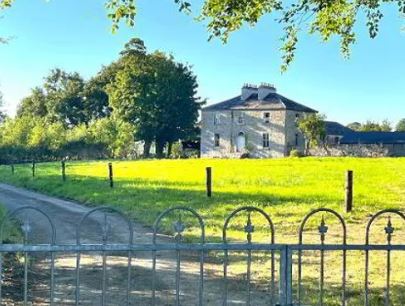
|
| Corrastoona More House | In 1749 Richard Kirwan was living at Coristoonamore. This house appears to have been the residence of K. Lyster [Kirwan Lyster?] in 1814 and of F.T. Byrne in 1837. Occupied by Patrick O'Connor in the mid 1850s, who held the house from Christopher Hamilton. Valued at £2 in 1906 and in the occupation of Sir N. O'Conor. It is no longer extant. | |
| Bopeep Lodge | A Blakeney property that was leased to H. French in the 1830s and to Robert French in the 1850s. |

|
| Dundermot | A Blakeney property, built circa 1750.Taylor and Skinner note is as occupied by Owens esquire in 1778. In 1786, Wilson refers to it as the seat of Samuel Owens Lee. It was the residence of Richard Kelly in 1814 and held by Patrick O'Connor at the time of Griffith's Valuation when the house was valued at £36. In the 1890s it became the home of the Blake-Kellys, although Nicholas O'Conor is recorded as the occupier in the valuation lists for 1906. Still extant and restored in the early 21st century. |

|
| Leabeg | Wilson refers to Leabeg as the seat of Mr. "Irvine" in 1786. The residence of Edward Irwin in 1814 and held by Daniel H. Irwin in fee at the time of Griffith's Valuation, when the house was valued at £6. It is described as "in ruins" on the 25-inch Ordnance Survey map of the 1890s. | |
| Ballymacurly | Andrew McDermott was farming at Ballymackeriley, parish of Cloonygormican in 1749. Occupied by Michael Nolan in 1837 and in the 1850s and held from Hugh O'Byrne. |

|
| Runnamoat | Runnamoat was occupied by Bryan Fallon in 1749 and noted by Wilson as a seat of the Fallons in 1786. It was the residence of James Fallon in 1814. Acquired by James Balfe, tenth son of Walter Balfe, the house passed by marriage to the Chichesters who leased it to Richard Kelly in the 1850s, when it was valued at £70. Occupied by Raleigh Chichester Constable in 1906. This house is sometimes referred to as Runnimead. Burnt in the 1920s. | |
| Newtown | Originally an Irwin property, bought by the Brownes in the 18th century. Held by the Very Reverend Henry M. Browne at the time of Griffith's Valuation and occupied by Henry Farmer. | |
| Mullen | In 1837 Lewis records a house named Mullen as the seat of Lynch Plunkett. The 1749 Census of Elphin records Mullen or Mullin, in the parish of Tibohine, barony of Frenchpark, as the residence of J. Barlow. The house, labelled Mullen, is shown on the 1st edition Ordnance Survey map but does not appear on the later 25-inch edition of the 1890s. | |
| Rathkeery Glebe | Rev. William French was leasing a glebe house at Glebe East, barony of Frenchpark, from Lord de Freyne's estate at the time of Griffith's Valuation when it was valued at £7. The house no longer survives but an entrance gateway and trees indicate its whereabouts. |

|
| Castleplunkett | Gormley states that the Plunketts built a mansion near Castleplunkett village sometime between 1655-1660. This building was later destroyed by fire in the mid-nineteenth century and the stones later used in building in the area. | |
| Derry Lodge | At the time of Griffith's Valuation, Elizabeth Sandford was leasing a house at Derry, barony of Frenchpark, valued at £6 from the French estate. The house is described in the Ordnance Survey Name books of 1837 as "a good house, two stories high and thatched". The first edition of the Ordnance Survey map indicates a mill and a building described as "site of old iron works" close to the site. A modern building is located at Derry now. | |
| Toomona | The home of Michael Connor, a gentleman in 1749, just outside Tulsk. The residence of Michael's grandson Peter O'Connor in 1814 and 1837. At the time of Griffith's Valuation Toomona was valued at £10 and was occupied by Maria French who held it from Lord Crofton. Later occupants included Colonel Lynham, Matt Flanagan, the Murphy and Fallon families. Accidently burnt in the 1970s. | |
| Bellanagare Castle | Bellanagare was the home of the O'Conor family including the well-known historian Charles O'Conor. It is noted by Wilson as his seat in 1786. He later built Hermitage House some distance away and Bellanagare Castle is now in ruins. |
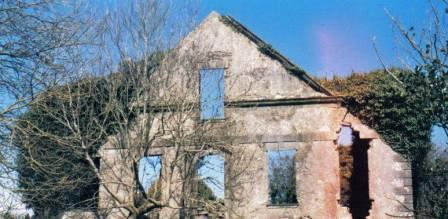
|
| Marnellsgrove | The home of the Marnell family at the beginning of the 19th century. Richard Marnell was resident in 1814. | |
| Dunmore Lodge | Melvin states that the Dunmore estate had been inherited by the Gores in the early eighteenth century and that Ralph Gore resided at Dunmore during that century. His mansion was subsequently in use as a barracks until it was destroyed during the Civil War in the early twentieth century. Marked on the Taylor and Skinner map of 1778 as the residence of the Earl of Ross and also noted as "the fine seat of the Earl of Ross" by Wilson in 1786. In 1814 Leet noted "Dunmore Lodge" as the residence of John Egan. | |
| Balydooley Lodge | John Hanley was leasing this property from St. George Caulfeild at the time of Griffith's Valuation, when it was valued at £5. It is still extant. | |
| Ashpark | In 1786 Wilson refers to Ashpark as the seat of Matthew Lyster. By the time of Griffith's Valuation this townland was in the possession of Christopher Hamilton and the most substantial house, valued at £4, was leased from his estate by Patrick Finner. Very little of the buildings are visible on the 25-inch Ordnance Survey map of the 1890s though farm buildings still exist at the site. | |
| Oran (Ballymoe) | In 1778 the residence of R. Malone esquire is recorded at Oran. Wilson also refers to this property as the seat of Lord Sunderlin [Richard Malone]. This residence may have been in the townland of Cartron, |

